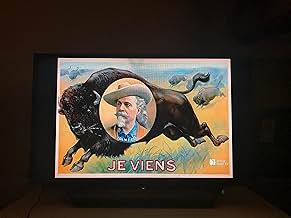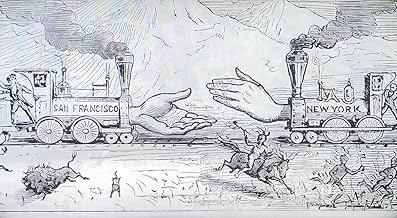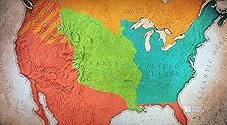Eine Reise durch mehr als 10.000 Jahre nordamerikanischer Geschichte und durch einige der berühmtesten Landschaften des Kontinents, die die Entwicklung des Säugetiers nachzeichnet.Eine Reise durch mehr als 10.000 Jahre nordamerikanischer Geschichte und durch einige der berühmtesten Landschaften des Kontinents, die die Entwicklung des Säugetiers nachzeichnet.Eine Reise durch mehr als 10.000 Jahre nordamerikanischer Geschichte und durch einige der berühmtesten Landschaften des Kontinents, die die Entwicklung des Säugetiers nachzeichnet.
- Stoffentwicklung
- Hauptbesetzung
- Auszeichnungen
- 1 wins total
Folgen durchsuchen
Empfohlene Bewertungen
10jmlj99
Hard to watch? Yes. It is heartbreaking. I started watching the show with my husband, it was very depressing, but the story and the history needed to be told and shared. We all need to know and remember how people wiped out the Native Americans and the lands and the buffaloes that sustained them. It's so hard to believe that people could not respect the land and lives of others in the past. That was the way in the past. Take what you want and who cares about the feelings and the lifestyle of the natives. I'm glad I'm in my 60's and it saddens me to see that we the American people still don't recognize how badly we screwed the native population.
I just finished watching The American Buffalo and once again Ken Burns hits it out of the park! I thought I knew the plight of the Bison, and how it also impacted Native Americans, but I learned much more about the history of the past 200 years. This is a very touching and thought provoking documentary and reminded me of the photo of a huge mountain of bison skulls I first saw as a child. I'd never even heard of the amazing meter shower of the 1880s or of the horrid Gore who killed thousands of animals just for fun. I'm looking forward to part 2 tomorrow night. At least enough calves were saved that the species did not go extinct. Thank God for Yellowstone Park.
Very simply, this film is an important story. I have to think that this is Ken, going out of his way, to subtly make a point. He could have told this story years ago, but choose "now" to do so. It is a tale of stunning ignorance and stupidity, and ought to be a must-see for everyone. Specifically, it shows how humans can simply choose to be blind to an unconscionable nightmare fiasco that they are creating, at a rapidly increasing speed, simply for the sake of money. It VERY MUCH mirrors what the larger human populace is repeating right now, except this time, WE are the buffalo.
Ken's film exhibits the fact that you can turn _some_ disastrous situations around, even though, historically speaking, we seem to have not been inclined to do so (just ask the Passenger pigeon, Tasmanian tiger, and even the mastodon, how it worked out for them).
Again, a great story. They should be showing it to kids in grade school, as that might result in some important conversations around the dinner table at home.
Ken's film exhibits the fact that you can turn _some_ disastrous situations around, even though, historically speaking, we seem to have not been inclined to do so (just ask the Passenger pigeon, Tasmanian tiger, and even the mastodon, how it worked out for them).
Again, a great story. They should be showing it to kids in grade school, as that might result in some important conversations around the dinner table at home.
The drive to near extinction of the American buffalo was perhaps inevitable: technology has given mankind many options to exploit nature, but without the sense of restraint to do so sustainably. What's shocking in this documentary is not just the speed with which the buffalo were exterminated, but that everyone could see what was happening and did nothing to stop it. They could also see that the end of the species would end the traditional way of life of the native human population; mostly, Americans of European ancestry saw this as a good thing. The second part tells the story of how the buffalo was saved; but it could be argued that the peoples who depended on it have never recovered. There's a warning here for all of us today as we face climate change: might we once again walk eyes-open into environmental catastrophe, not appreciating what we have until after it has gone?
Heartbreaking documentary about the exploitation and near extinction of the bison, along with the destruction of Native American cultures which depended on the animals for food, clothing, bone tools, tepee hides. Historians on the program include Native Americans and as usual with Ken Burns, the narration includes voices reading historical records.
From what I read, the second episode is more optimistic and describes the attempt to bring the buffalo back to the prairie. Maybe I will watch that one, but I had to bail on the first episode about halfway through. It was just too, too cruel to watch.
From what I read, the second episode is more optimistic and describes the attempt to bring the buffalo back to the prairie. Maybe I will watch that one, but I had to bail on the first episode about halfway through. It was just too, too cruel to watch.
Wusstest du schon
- WissenswertesA hour long conversation preview with Ken Burns and indigenous leaders is hosted by Judy Woodruff on PBS 23 September.
- VerbindungenFeatured in Ken Burns: One Nation, Many Stories (2024)
Top-Auswahl
Melde dich zum Bewerten an und greife auf die Watchlist für personalisierte Empfehlungen zu.
- How many seasons does The American Buffalo have?Powered by Alexa
Details
- Erscheinungsdatum
- Herkunftsland
- Offizieller Standort
- Sprache
- Auch bekannt als
- The American Buffalo
- Produktionsfirmen
- Weitere beteiligte Unternehmen bei IMDbPro anzeigen
- Laufzeit3 Stunden 54 Minuten
- Farbe
Zu dieser Seite beitragen
Bearbeitung vorschlagen oder fehlenden Inhalt hinzufügen

Oberste Lücke
By what name was Der Amerikanische Bison (2023) officially released in India in English?
Antwort



























